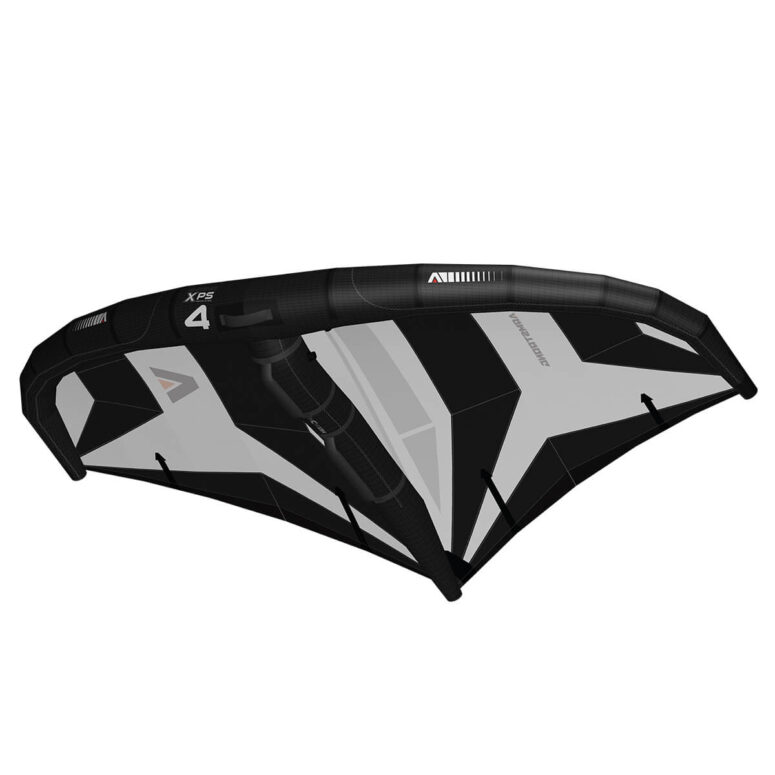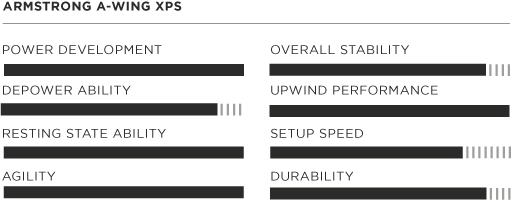

When you purchase gear through links on our site, we may earn a small commission. Here’s why you can trust our tests and our affiliate partner.

The original Armstrong A-Wing was notoriously powerful per size, and suited many riders at the fledgling stages of the sport, where priority was to get on foil and thrust oneself along without prejudice. As wingfoiling has progressed so rapidly in the last couple of years, equipment needs to match increasing skill levels, and with more refinement in power delivery required for more complex and subtle maneuvers, it was time for the A-Wing to evolve and that’s exactly what Armstrong have done. The XPS has been through a ground-up redesign process stretching over two years, with around 100 prototypes produced across the size ranges with various new potential materials tried and tested.
First of all, let’s hit on the hot topic of airframe materials. The bulk of the airframe is made from DLE 160 Dacron and is relatively standard with internal reinforcement internally across the shoulder curve of the LE with DLE 130 which is a little lighter and stiffer. This double up of two complimentary materials stiffens the airframe a treat where required. So, in essence, standard materials were used to purposefully allow flex when the wing is loaded as well as provide a little comfort and flex in the wing. In the wingtips, they’ve pre twisted the shape in the opposite direction to its predicted load, to achieve their intended design when the wing is actually in use, with the force of the wind on it.
On inflation, which is handled by bayonet valves on the strut and leading edge, it’s obvious that the XPS has been designed with much attention to detail in the canopy. Firstly the sail paneling seems to sit perfectly with no wrinkles anywhere, and it pre tensions itself drum tight with the most elegant and effective pre-loading of a canopy we’ve yet to see on the market. The deeper profile section in the front of the canopy is locked in place, and the panel layout and seaming distributes load towards the tip of the strut much like the clew of a sail, also taking into account the warp and weft of the material, orientating the cloth for minimum stretch. Small removable carbon battens in small pockets also help control the trailing edge. DLE 130 also frames the canopy as an intermediate on the leading edge juncture. Armstrong have coined this their Cross Panel Sail design, hence the XPS moniker. Windows are sensibly placed above and below the boom, lightweight and noticeably clear TPU. The strut is curved to balance the load evenly between your hands and orientate the sail most ergonomically towards the body and the profiled section of ripstop sits creased until it’s loaded, once the sail fills it’s tight and all makes sense.
The handles strike an excellent middle ground. It’s essentially a solid carbon bar with webbing sewn in over the top providing texture, EVA foam sandwiched inside. This little bit of give enhances comfort over a rounded plastic and foam system, and your arm fatigue won’t build as fast as with a higher diameter rounded grip. The squared profile allows an extra layer control by flexing your wrist control in gusty conditions, and you can hook your fingers over comfortably. The handle ends have soft coverings and won’t damage your board. If you want to bridge the two with a harness line, it’s super simple with two dedicated loops present. The front handle has enough clearance on the strut to adopt a pistol grip style, which can be a huge control bonus over the nose handle, which is positive and stiff, for onshore wave riding. The provided wrist leash is long and elasticated, and has a huge stretch so it’s easy to paddle with. There’s a constricting wrist cuff with a small integrated spinner.
In the hands the XPS immediately feels tight and solid, there’s zero flutter in the wing, even when overpowered. Forward drive, speed and upwind ability are phenomenal, and that lack of flutter and associated drag only enhances the feeling of efficiency further. The wing has a significantly wide and usable power band, and the short span makes it delightfully easy to rotate. In an onshore wave scenario it was easy to whip the wing across horizontally in front of your body as you changed direction. Round the corners, you can tell plenty about a wing’s stability from a high-speed aggressive tack, where things remain exceptionally composed. Initiating lift, the tight canopy and rigidity seemed to allow for pokey ascents and floaty landings, with the wing holding shape well.
The wingfoiling equivalent of a scalpel, the XPS precisely slices through a range of conditions with extreme accuracy. It’s combination of searing upwind ability, ghost-like flagging and general superb handling whilst overhead and through the bends enables the rider playful mobility for freeride and wave use. Relatively standard materials and sensible inflate pressures would perhaps lead you to underestimate the performance potential, but don’t be fooled, this is a rapid, tight and solid feeling wing with delightfully progressive power delivery.
